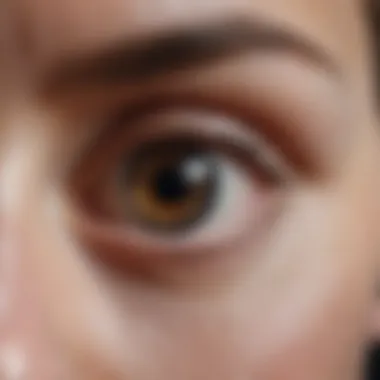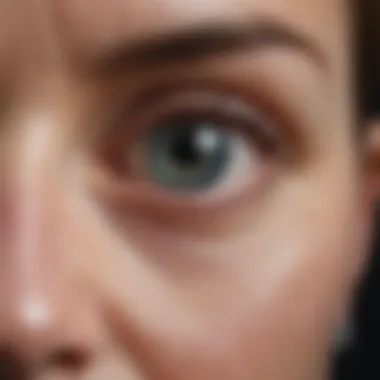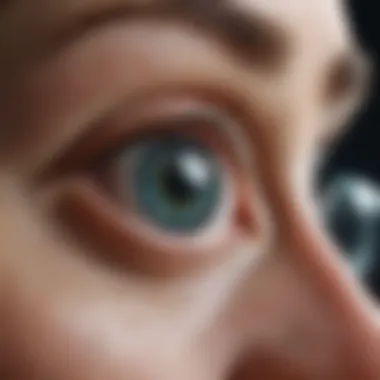Understanding Diabetes and Cataracts Link


Intro
Diabetes and cataracts represent two significant health challenges faced by millions around the globe. Both conditions silently occur, often leading to serious complications if not managed properly. The relationship between diabetes and cataract formation is particularly alarming. Studies have shown that individuals with diabetes have a much higher risk of developing cataracts compared to those without the condition. This connection is not merely coincidental; it arises from complex biochemical processes fueled by prolonged high blood sugar levels. Understanding this relationship is crucial for implementing effective preventive and treatment strategies.
The increase in blood sugar affects the eye's lens, causing changes that ultimately lead to clouding, reducing vision quality. With increasing rates of diabetes worldwide, the potential for more significant cataract incidence becomes a vital issue for public health.
This article seeks to dissect the underlying mechanisms connecting diabetes to cataracts, while also discussing treatment options and preventive measures. Moreover, it highlights areas for future research, recognizing that ongoing investigation is essential to mitigate this growing health concern.
Methodology
Overview of research methods used
Data collection techniques
Data for this exploration was sourced from multiple medical journals and databases. The analysis concentrated on long-term studies that monitored diabetes patients for cataract development. Advanced data analytics techniques were employed to obtain reliable results, ensuring that findings accurately reflect the relationship between the two conditions. This meticulous approach provides a robust foundation for the conclusions drawn in this article.
Implications of Prolonged Hyperglycemia
Prolonged hyperglycemia leads to various metabolic changes in the body. In the eye, it can alter the lens's biochemical properties, making it more prone to cloudiness. Elevated glucose levels increase the formation of sorbitol through the polyol pathway, mediated by the enzyme aldose reductase. Sorbitol accumulation in the lens leads to osmotic pressure changes, resulting in swelling and ultimately clouding due to protein aggregation.
Key aspects include:
- Disruption of lens flexibility
- Alteration in the composition of lens proteins
- Formation of advanced glycation end-products (AGEs) that contribute to lens opacity
The interplay between diabetes and cataracts emphasizes the importance of early management of blood glucose levels to maintain ocular health.
Future Directions
Upcoming trends in research
As the link between diabetes and cataract formation becomes clearer, new avenues of research have emerged. For instance, an increasing number of studies investigate the possibility of incorporating ocular health assessments in routine diabetes management.
Areas requiring further investigation
Despite significant progress, many areas still require attention. More research must focus on the mechanisms of lens transparency loss in diabetics, particularly relating to different blood glucose control strategies. Additionally, exploring the effectiveness of emerging treatments and preventive measures for at-risk populations could provide valuable insights into managing ocular health in diabetics.
Prolusion to Diabetes and Eye Health
Understanding the connection between diabetes and eye health is essential in healthcare. Diabetes is not just a metabolic disorder; it has profound implications for various parts of the body, particularly the eyes. This section explores the importance of eye health in patients with diabetes and sets the foundation for further discussions on cataracts.
Overview of Diabetes
Diabetes is a chronic health condition characterized by high levels of sugar in the blood. The two main types are Type 1 and Type 2 diabetes. In Type 1 diabetes, the body does not produce insulin, while in Type 2, the body does not respond properly to insulin. This disorder affects millions of people worldwide and can lead to various complications if not managed effectively. Managing diabetes often involves monitoring blood sugar levels, dietary changes, and lifestyle modifications.
Diabetes affects not only the metabolic system but also has serious implications for ocular health. The prolonged state of elevated blood sugar can result in damage to the blood vessels in the eyes, leading to a range of eye-related issues, including cataracts. This makes understanding diabetes crucial for preventing vision-related complications.
Significance of Ocular Health
Ocular health is paramount for overall well-being. Eyes are essential for a range of daily activities, from reading to driving. For individuals with diabetes, the risk of developing serious eye diseases increases significantly. Diabetic retinopathy, glaucoma, and cataracts are among the most commonly associated conditions. These conditions not only affect vision but can also lead to permanent blindness if left untreated.
Regular eye examinations are particularly significant for diabetics. They can help identify problems before they become severe, potentially preventing vision loss. Knowledge of how diabetes impacts eye health informs patients and caregivers, encouraging proactive management strategies.


"Early detection and consistent monitoring are key to protecting vision in diabetic patients."
In summary, the significance of understanding both diabetes and ocular health cannot be overstated. This knowledge is essential as it lays the groundwork for examining the connection between diabetes and the increased risk of developing cataracts. A comprehensive approach to managing diabetes includes awareness of its possible effects on eye health, underscoring the necessity of regular check-ups and timely interventions.
Understanding Cataracts
Cataracts represent a significant ocular health issue, particularly as they relate to diabetes. Understanding cataracts is crucial for those who are diabetic or at risk of developing diabetes. The condition can severely affect visual acuity and overall quality of life. It is important to note how cataracts form and the factors that influence their development, especially in individuals with diabetes. This understanding equips patients and healthcare professionals with the knowledge needed to track symptoms and implement preventive strategies.
Definition of Cataracts
Cataracts refer to the clouding of the lens in the eye, which can lead to diminished vision. The lens is crucial for focusing light onto the retina, and when it becomes opaque, images can appear blurred or distorted. Various factors can contribute to cataract formation, but diabetes is a well-documented risk factor. The process often unfolds gradually, allowing for the possibility of early intervention if detected.
Types of Cataracts
There are several types of cataracts, each with distinct characteristics and progression mechanisms. The main types include:
- Nuclear cataracts: These develop in the center of the lens, typically associated with aging and can initially cause nearsightedness.
- Cortical cataracts: These form at the lens's outer edges and can create visual distortions and halos around lights.
- Subcapsular cataracts: This type occurs towards the back of the lens and can develop quickly, often associated with diabetes or high steroid use.
- Congenital cataracts: Present at birth, though they are rare and can arise from genetic factors or maternal influences during pregnancy.
Understanding these types aids in recognizing symptoms and determining the appropriate treatment options.
Symptoms and Diagnosis
Symptoms of cataracts can vary but often include:
- Blurry or cloudy vision
- Difficulty seeing in low light conditions
- Halos around lights
- Increased sensitivity to glare
- Changes in color perception
- Frequent changes in prescription glasses or contact lenses.
Diagnosis typically involves a comprehensive eye examination conducted by an ophthalmologist, including visual acuity tests and slit-lamp examinations. Early detection is critical, especially for diabetic individuals, to prevent significant vision loss.
The Biochemical Link Between Diabetes and Cataracts
Diabetes significantly contributes to various ocular complications. Understanding the biochemical link between diabetes and cataracts is crucial for several reasons. First, it allows for better prevention strategies for at-risk patients. Second, identifying these links can inform treatment pathways for those already diagnosed with cataracts. By evaluating key biochemical processes in diabetic patients, one can grasp how prolonged high blood sugar levels adversely impact the eye, leading ultimately to cataract formation.
Hyperglycemia's Role
Sorbitol accumulation can cause osmotic and oxidative stress on lens fibers. This stress contributes to clouding of the lens, a characteristic of cataracts. Furthermore, prolonged hyperglycemia is often correlated with other complications of diabetes.
Advanced Glycation End-products (AGEs)
Advanced Glycation End-products, commonly known as AGEs, are another fundamental factor linking diabetes and cataract development. AGEs result from a non-enzymatic reaction between sugars and proteins or lipids, leading to protein cross-linking and dysfunction. In the ocular context, AGEs accumulate in the lens over time, resulting in changes to its physical and chemical properties.
This accumulation not only disrupts the transparency of the lens but also contributes to its stiffness. The presence of AGEs can promote inflammation and reinforce oxidative stress in the eye, both factors that accelerate cataract formation. The mechanisms by which AGEs influence the pathogenesis of cataracts underscore the importance of controlling blood sugar levels to prevent their accumulation.
Oxidative Stress Implications
Oxidative stress plays a significant role in cataractogenesis among diabetic patients. High glucose levels lead to an overproduction of reactive oxygen species. This increase can overwhelm the body’s antioxidant defenses, creating an imbalance.
Consequently, oxidative stress can damage lens proteins and lipids, promoting the development of cataracts. Evidence suggests that antioxidants may help mitigate these effects, highlighting the need for ongoing research into potential therapeutic strategies that could protect against oxidative damage in the context of diabetes. Furthermore, understanding these oxidative processes may lead to more effective interventions that specifically address the oxidative aspect of cataract development in diabetic individuals.
The intricate interplay between hyperglycemia, AGEs, and oxidative stress frames a clearer picture of how diabetes affects eye health, particularly through cataract formation.
Risk Factors for Cataract Development in Diabetic Patients


Understanding the risk factors for cataract development in diabetic patients is crucial. It allows for better identification of those at higher risk and enhances strategies for early detection and prevention. Several specific elements impact the likelihood of developing cataracts in individuals with diabetes. These factors can include the duration of diabetes, blood sugar control, and the presence of comorbid health conditions. Addressing these factors can lead to improved health outcomes and ocular health.
Duration of Diabetes
The duration of diabetes plays a significant role in cataract formation. Longer exposure to elevated glucose levels can cause cumulative damage to the lens of the eye. Research indicates that patients who have lived with diabetes for more than ten years are at a markedly higher risk for developing cataracts compared to those newly diagnosed.
This extended period of hyperglycemia can influence the biochemical processes that lead to cataractogenesis. Over time, the lens becomes increasingly susceptible to changes in osmotic pressure and oxidative stress, making it imperative for long-term diabetics to have regular eye examinations.
Blood Sugar Control
Blood sugar control is another critical factor. Individuals who maintain stable blood glucose levels have a lower risk of cataract development. Frequent spikes in blood glucose can accelerate the formation of cataracts, as high glucose levels contribute to the accumulation of sorbitol in the lens. This leads to osmotic changes that can cloud the lens.
Effective diabetes management includes careful monitoring of blood sugar levels. It often involves lifestyle changes, medication adherence, and regular check-ups with healthcare providers to prevent long-term complications like cataracts.
Comorbid Health Conditions
The presence of comorbid health conditions can also increase the risk for cataracts in diabetic patients. Chronic illnesses such as hypertension and heart disease can complicate the management of diabetes. Additionally, certain medications used to treat these conditions may have side effects that exacerbate the risk of cataract formation.
A multifactorial approach is essential when considering the overall health of diabetic patients. Addressing comorbidities through a comprehensive health plan is vital to reduce not only the risk of cataracts but also other diabetes-related complications. Regular screenings and collaborative care can help manage these conditions while keeping cataract risk in check.
Key Takeaway: Understanding these risk factors highlights the importance of proactive management in diabetic patients to prevent cataract development. Regular medical evaluations and lifestyle adjustments are foundational in safeguarding eye health.
Preventive Measures for Diabetics
Preventive measures are crucial for diabetics to safeguard their ocular health. Diabetes significantly increases the risk of developing cataracts due to biochemical changes in the lens of the eye. By adopting proper preventive strategies, it is possible to slow disease progression and maintain overall eye health. The following sections will discuss specific measures that can be taken to mitigate the risk of cataracts in diabetic patients.
Regular Eye Examinations
Regular eye examinations should be a priority for individuals living with diabetes. Eye care professionals can detect the early signs of cataracts and other complications through comprehensive eye exams. These check-ups enable timely intervention, reducing the likelihood of serious vision loss. Patients are advised to have an eye exam at least once a year, or more frequently if recommended by their healthcare provider.
Maintaining Healthy Blood Sugar Levels
Maintaining stable blood sugar levels is essential in reducing the risk of cataracts. High blood sugar can cause changes to the lens of the eye, leading to cloudiness. Controlling glucose levels is achieved through a combination of diet, medication, and lifestyle changes. A focus on regular monitoring helps anticipate fluctuations, thus minimizing glucotoxicity, which plays a significant role in ocular complications.
Lifestyle Modifications
Making significant lifestyle modifications can have a profound impact on reducing cataract risk for diabetics. Changes in diet, physical activity, and avoiding harmful substances contribute positively to overall health.
Balanced Diet
A balanced diet is foundational in diabetes management. It focuses on consuming a variety of nutrients while controlling calorie intake. A diet that includes whole grains, lean proteins, fruits, and vegetables supports blood sugar control and reduces inflammation. The key characteristic of a balanced diet is its emphasis on whole foods over processed options. This approach benefits diabetics by promoting stable glucose levels and providing essential nutrients for eye health. However, it is also important to be aware of carbohydrate intake, as it can affect blood sugar levels directly.
Physical Activity
Engaging in regular physical activity can help manage diabetes effectively. Exercise improves insulin sensitivity and enhances overall metabolism, which benefits ocular health. The unique feature of physical activity lies in its ability to lower blood glucose levels naturally. Regular exercise also may help with weight management, reducing stress, and boosting mood. While it has significant advantages, it's vital to note that diabetics should consult with their healthcare professionals before starting any new exercise program to avoid potential risks.
Smoking Cessation
Quitting smoking is one of the most important lifestyle changes for diabetics. Smoking exacerbates the risks associated with diabetic eye diseases, including cataracts. The key characteristic of smoking cessation is its potential to improve blood circulation and reduce inflammation. This not only benefits eye health but overall well-being as well. Implementing smoking cessation programs can offer support and resources to help individuals quit. Although the path to cessation can be challenging, the long-term advantages for ocular health and life quality are significant.
Treatment Options for Cataracts in Diabetic Patients


Cataracts are a common complication among individuals with diabetes, making understanding treatment options essential. Diabetic patients face unique challenges when it comes to cataract management due to underlying metabolic issues that can complicate surgical outcomes. Addressing cataracts early can help minimize vision loss and enhance quality of life. Effective treatment strategy should consider both the individual's diabetes control and the health of their eyes.
Surgical Intervention Techniques
When non-surgical options do not sufficiently address symptoms, surgical intervention becomes necessary. The primary method of cataract treatment is phacoemulsification. This procedure involves the use of ultrasonic vibrations to break down the cloudy lens, which is then gently suctioned out. A new intraocular lens (IOL) is usually implanted to restore vision. This procedure is generally safe, but diabetic patients might face higher risks of complications. It is critical for the surgeon to assess each patient's individual case, particularly regarding blood sugar levels and overall health, before proceeding with surgery.
Other surgical techniques like manual small incision cataract surgery might be considered in certain conditions. These methods can cater to specific patient needs, such as preferences for quick recovery or potential complications from diabetes.
Prior to any surgical procedure, patients are advised to maintain optimal blood sugar levels. This helps reduce the risk of infection post-surgery and leads to a smoother recovery process. Patient education about risks associated with surgery is also vital.
Post-Surgery Considerations
After cataract surgery, particular attention is needed for diabetic patients during recovery. Monitoring blood glucose levels continuously is crucial. Elevated levels can impede healing and increase the risk of infections.
Post-surgery, patients typically receive specific instructions that may include:
- Avoiding strenuous activities for a few weeks to prevent eye strain.
- Regular follow-ups with eye care professionals to monitor for complications.
- Using prescribed eye drops to prevent inflammation and fight infection effectively.
Optimal recovery time varies, but adhering to a doctor's guidelines can significantly reduce risks and enhance outcomes. Moreover, regular eye check-ups after surgery are necessary to maintain ocular health, especially in diabetic patients.
“Effective management of diabetes not only helps in preventing cataracts but also ensures better outcomes post-surgery.”
Future Directions in Research
Investigating New Therapeutic Approaches
Emerging therapeutic techniques for managing cataracts in diabetic patients are of significant interest. Research is ongoing to identify pharmacological interventions that might mitigate the formation of cataracts. For instance, clinical trials on eye drops that may influence the lens's biochemical environment are under investigation. The promise of non-invasive treatments provides hope for reducing the need for surgical interventions, particularly for patients at high risk due to diabetes. Additionally, exploring combination therapies that could enhance the overall treatment effectiveness could lead to breakthroughs in managing cataracts within this demographic.
Understanding Genetic Factors
Genetic predispositions in diabetes patients may influence the likelihood of cataract development. Identifying specific genetic markers linked to cataract formation could yield insights into why some individuals develop these lens opacities while others do not. This understanding has potential implications for tailoring individual treatment plans. By mapping out the genetic profiles associated with cataracts, researchers can establish better predictive models, leading to customized prevention strategies. Moreover, research on epigenetic modifications due to prolonged hyperglycemia might shed light on the mechanisms driving lens changes, opening new avenues for intervention.
"Understanding the genetic basis of disease not only aids in diagnosis but also provides strategic pathways for treatment."
In summary, focusing on new therapeutic approaches and genetic factors paves the way for significant advancements in managing the cataract implications of diabetes. As research progresses, these areas hold the key to reducing the burden of cataracts in diabetic patients and enhancing their quality of life.
Finale
The conclusion of this article is vital as it consolidates the intricate relationship between diabetes and cataracts while emphasizing the importance of preventive measures and research advancements. Understanding this connection helps both patients and healthcare providers manage risks effectively. Insights from this discussion underscore that appropriate diabetic care can significantly lower the likelihood of cataract development, thus safeguarding vision.
Summary of Key Points
In the preceding sections, we have discussed several essential aspects of diabetes and cataracts:
- Diabetes and Eye Health: Diabetes poses a significant risk to ocular health, necessitating regular eye check-ups.
- Cataract Mechanisms: Elevated blood sugar levels lead to biochemical changes in the lens, promoting cataract formation.
- Risk Factors: Prolonged diabetes duration and poor glycemic control elevate cataract risks.
- Preventive Strategies: Regular monitoring and lifestyle adjustments play critical roles in prevention.
- Treatment Options: For those already affected, surgical intervention remains a primary solution.
- Future Research: Understanding genetic influences may open new avenues for treatment and prevention.
These points illustrate the multifaceted nature of risk, highlighting key interventions that can improve patient outcomes.
Implications for Diabetic Care
The implications for diabetic care are profound and multifactorial. First, regular eye examinations are crucial for early detection of cataracts, allowing for timely interventions. Secondly, maintaining optimal blood sugar levels not only aids in overall health but also mitigates the risk of cataracts. Ultimately, healthcare professionals must educate patients on the importance of lifestyle modifications, encompassing:
- Balanced diet
- Regular physical activity
- Smoking cessation
These elements are fundamental not just for managing diabetes, but also for preserving eye health.
By prioritizing these factors in diabetic care, we can significantly reduce the incidence of cataracts and enhance the quality of life for individuals living with diabetes.







